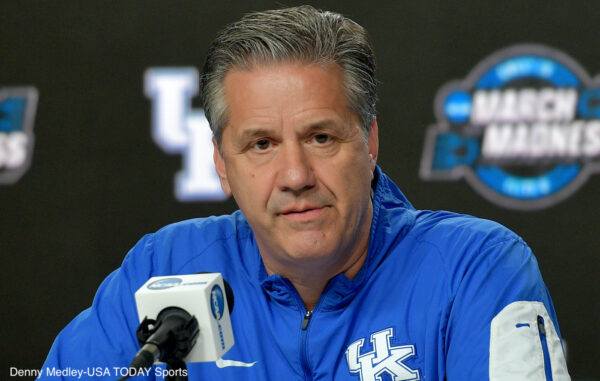Analysis: Why these four college basketball blue blood programs are struggling
This college basketball season has been unlike any other in recent memory, especially for some of the premier, blue blood programs. The best, most accomplished program in each of college basketball’s top four conferences are having their worst season in recent years.
The door has opened for dormant programs and smaller names to compete for conference titles and top seeds, with the usual suspects in those positions left swimming upstream. In some cases, this has meant a speed bump that needs to be ironed out to set up a tournament run. For others, the tournament is slowly fading from their grasp.
Here is how four of America’s most notable and successful basketball programs have struggled, and what needs to happen for a turnaround.
Kentucky (5-10, 4-4 in SEC)
Since John Calipari took over the Kentucky program in the 2009-10 season, his teams have suffered a three-game losing streak just three times. Two of those were this season, including a six-game skid that left Big Blue Nation catatonic with a 1-6 record to start the year.
Calipari is once again trying to assimilate a team of newcomers on the fly, with returning players accounting for just 4.3 percent of last year’s minutes. That’s low, even for Calipari. It’s his lowest mark at Kentucky and only the second time he’s been below 10 percent – the other coming in 2013, Cal’s only time missing the Big Dance in Lexington.
This young, gelling team has just been lost offensively. Kentucky’s two lead guars, Devin Askew and Terrence Clark, are both turning the ball over more than a quarter of the time they “use” an offensive possession. Top prospect Brandon Boston has been worse, statistically placing among the least efficient players in the sport. He’s made just 9 of his 50 attempts outside the arc (18 percent) and hasn’t been stellar when driving either.
For Kentucky to turn things around, the freshmen will need to grow up fast or take a backseat to transfers like Olivier Sarr, Davion Mintz, and Jacob Toppin.
Michigan State (8-4, 2-4 in Big Ten)
Sparty has lost more than six conference games just once in the last ten years and has not missed the NCAA Tournament since 1997. Those marks could both be in play for Michigan State this season. The Spartans are just 2-4 in conference play. Home losses to Northwestern and Purdue are red flags for this team.
Michigan State’s biggest issue has been atypical for a Tom Izzo team. While the Spartans lead the nation in assist rate (dishing a dime on more than 70 percent of their field goals), they have struggled with turnovers. No Big Ten team is allowing opposing defenses to rack up steals more than the Spartans. Dead ball turnovers are one problem, but Tom Izzo himself coined the term “turnovers for touchdowns” in recent years when harping on the problems with live ball turnovers. Opposing teams are getting into transition and sneaking easy buckets against a deep, talented Michigan State team.
Duke (5-5, 3-3 in ACC)
It’s also troubling for Michigan State’s tournament resumé that the best win in Sparty’s pocket is a road victory over an unimpressive Duke team. The Blue Devils lost three straight road ACC games to fall to just 3-3 in the conference.
Coach K’s team is the fifth least experienced roster in all of college basketball, and it has shown in Duke’s penchant for making mistakes and lack of aggressiveness. The Blue Devils rank 337th in free throw rate, out of the 347 Division teams in play this season. On top of that, Duke is allowing the highest free throw rate in the ACC on the defensive end. In six conference contests, Duke is 56-83 at the line, compared to 91-125 for its opponents.
That is a massive chasm to make up, which Duke has failed to do. With turnover prone guards and shooters in a collective slump, the Blue Devils need to make adjustments to build a tournament worthy resumé.
Kansas (10-5, 4-4 in Big XII)
The Jayhawks are the best team on this list, but there are still plenty of unanswered questions in Lawrence after three straight road losses. Since 2004, Kansas has won or shared all but one Big XII regular season title. This year, the Jayhawks’ chances at a title is in as much jeopardy as it ever has been, with the Jayhawks sitting at 4-4 in conference play, 3.5 games behind undefeated Baylor.
Kansas’ problems don’t have any obvious answers hiding on Bill Self’s roster. With Devon Dotson gone to the NBA, Self’s plan to have Marcus Garrett shift to the point guard role has been clunky. His reliance on center David McCormack has also been called into question of late. At times, McCormack’s scoring on the block has been Kansas’ most reliable chance to spark its offense. In other, more frequent times, that overreliance has been a black hole. Self has flirted with playing no big men in favor of five perimeter players to spread out the offense. Until McCormack can play more dependably, Self may have to commit to small ball to open up scoring chances for his talented guards.
Shane McNichol covers college basketball and the NBA for Larry Brown Sports. He also blogs about basketball at Palestra Back and has contributed to the Action Network, Rush The Court, ESPN.com, Rotoballer, and USA Today Sports Weekly. Follow him on Twitter @OnTheShaneTrain.
